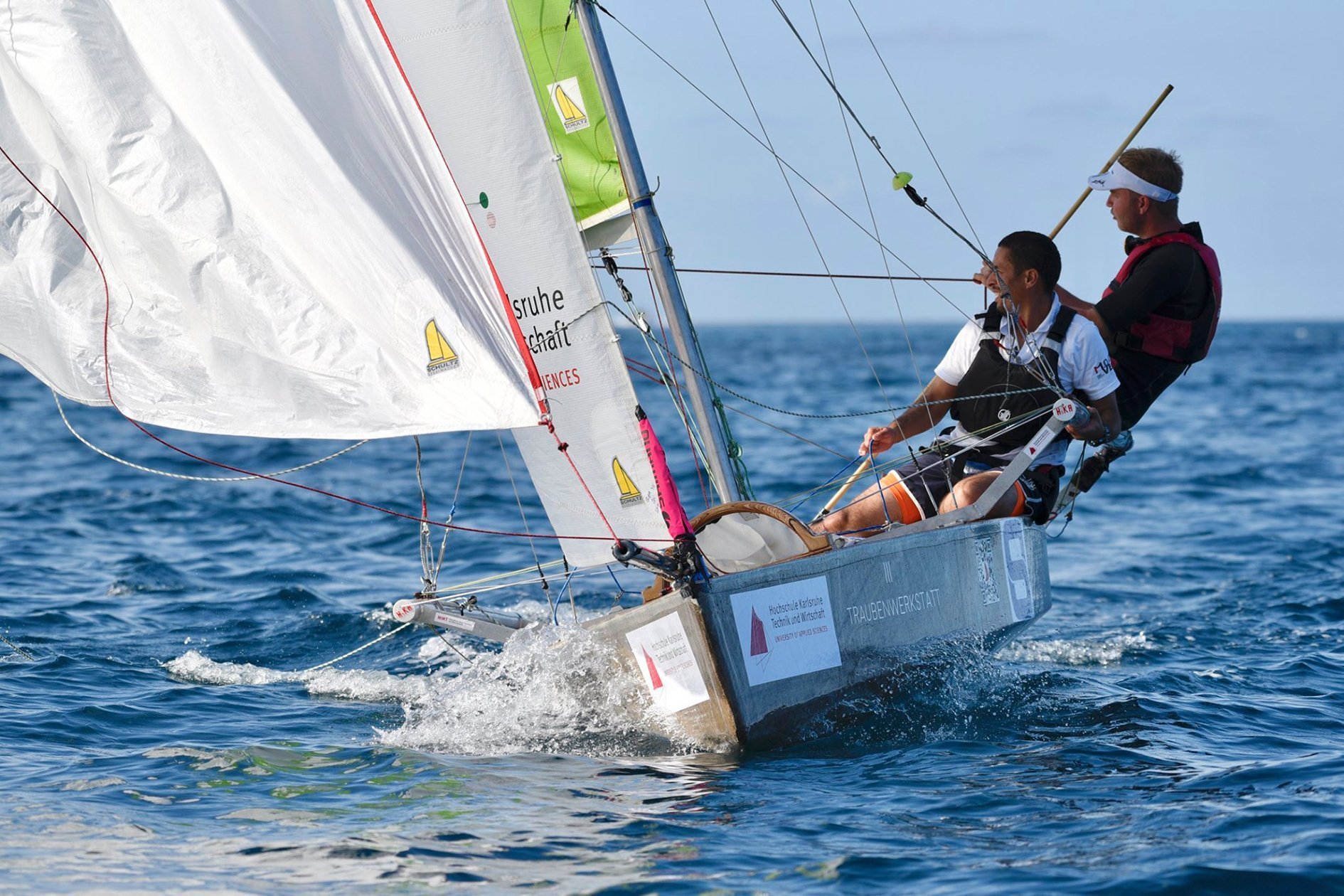
After Greta Thunberg made her sustainable trip across the Atlantic with the Malizia II racing yacht as an alternative to flying, the carbon hull of the yacht was much discussed all over the world because this material anything but sustainable. However, it is still the safest and best choice for the tough conditions on the high seas. For now at least – because the ecosail project team under Prof. Fahmi Bellalouna at the Karlsruhe University of Applied Sciences is currently working on making boatbuilding more sustainable.
For the 1001 VELA Cup 2019, launched in 2006 by the University of Palermo together with the University of Naples, the team developed a dinghy which – based on its weight – consists of 70% natural materials to comply with the competition requirements. In the end, the German team with its Mach 1 took 5th place in the international professional student competition with green boats.

Tropical wood and frame structure
The boat, which weighs about 110 kg, resembles a 470 – an Olympic two-man racing dinghy with trapeze and spinnaker – but is made of laminated flax fabric with 50 % natural resin content. In addition, the inner hull structure, a frame structure, is made of tropical Okoumè wood and Sapelli wood. This tropical wood is characterized by its high strength and low weight. The deck of the Green Dinghy is made of birch wood. In addition to the above properties, it is also relatively flexible.
Bellalouna explains the background and the future of construction and materials:
“The inner structure of the fuselage consists of a frame construction and the use of light but stable Okoumè and Sapelli wood species. This lightweight construction led to a high weight reduction and more stability of the hull. Furthermore, the use of flax fabric as a light and high-strength natural fiber and vacuum pressing as a laminating process gave the fuselage shell a stable and light hull form.
“The use of natural fibers, e.g., flax, jute and alfalfa grass, is comparable to wood due to the very positive ecological balance. They have the ability to thrive in dry and water-poor areas and can be harvested several times a year. Natural fibers also have very good mechanical properties. Thus they will gain more importance in the future in industrial applications, e.g., in automotive, shipbuilding and aircraft construction.”
Cross-industry: Natural fibers for industrial production
The aim of the ecosail project is not only to investigate and evaluate the industrial use of natural fibers in boatbuilding. After all, the student sailing team has now proven the suitability of the developed concepts in practice. The next step is to present these concepts to potentially interested companies at trade exhibitions and in specialist publications. The university team hopes for further possible cooperation agreements. The students, many of whom are professional sailors, are already working in close cooperation with yacht design and production companies.

In principle, all university teams participating in the 1001 Vela Cup are supported by sponsors from the sailboat construction and construction industry. At the same time, the companies use the event as an intensive exchange platform as well as a source of inspiration for the development of their new concepts.
Bellalouna is delighted:
“The interest of customers in environmentally friendly and sustainable products has also reached the boat market. Sailing is per se an environmentally friendly and sustainable form of mobility that only uses wind and thermal as energy sources. As a result, many customers now pay attention to the composition of materials and the manufacturing processes of sailboats. This development is often confirmed by experts – such as designers, engineers, shipyard workers from the boat and heavy cruiser shipbuilding industry.”
But there is still a long way to go. Bellalouna explains:
“Boat and heavy cruiser ship building are very expensive due to the number of pieces and the size of the market. Therefore, manufacturers try to use established materials and manufacturing processes in order to reduce costs. The use of new ecological materials and manufacturing processes is technically very risky and economically unprofitable due to the lack of long-term tests. Most boat and heavy cruiser ship builders are small shipyards that cannot bear this technical and economic risk. And in research, there are universities and institutes in Germany and around the world that are dedicated to the development of sustainable concepts for small boats and heavy cruiser ships, but it is not a lucrative field of research.”
Hybrid fiber instead of pure carbon
Even though natural fibers could represent an alternative to carbon and plastic fibers in the long term due to their very good mechanical properties and excellent ecological balance, Bellalouna sees their future task more in the area of hybrid fibers, which are composed of natural and plastic fibers. Because, according to Prof. Bellalouna:
“The production of hulls using composite materials made of epoxy resin and plastic fibers cannot be 100% avoided in the medium term due to the economic efficiency and good technical control with regard to load and production. Of course, this depends on further development in the field of natural composite materials.”
Interdisciplinary green boat building
A total of 25 students were involved in the 8,000 hour boat construction of the pioneering ecosail dinghy. They came from the fields of mechanical engineering, mechatronics, automotive engineering, industrial engineering and international management.
The next 1001 VELA Cup will take place from 17 to 22 September 2020 in the Gulf of Palermo. In addition to the Karlsruhe University of Applied Sciences, two other German universities, the Kiel University of Applied Sciences and the Eastern Westphalia-Lippe University of Applied Sciences, will be present with their own teams.

